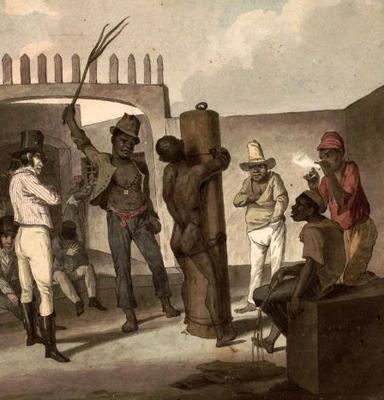 Portuguese explorers “discovered” Brazil in the year 1500, soon thereafter exporting Brazilwood to Europe, a valuable raw material used for making bows for string instruments and the source of a dye used for luxury fabrics. Little attention was paid to developing the colony until competition from other European nations pushed the Portuguese to expand and defend their settlements. In order to fuel the growing plantation economy, the Portuguese enslaved indigenous peoples. However, devastating European disease and the escape of indigenous peoples into the massive tropical interior made Brazil’s índios difficult to subdue.
Portuguese explorers “discovered” Brazil in the year 1500, soon thereafter exporting Brazilwood to Europe, a valuable raw material used for making bows for string instruments and the source of a dye used for luxury fabrics. Little attention was paid to developing the colony until competition from other European nations pushed the Portuguese to expand and defend their settlements. In order to fuel the growing plantation economy, the Portuguese enslaved indigenous peoples. However, devastating European disease and the escape of indigenous peoples into the massive tropical interior made Brazil’s índios difficult to subdue.
Instead, over the course of 300 years the Portuguese brought an estimated 4.9 million West African slaves to fuel the sugar, cotton, tobacco, and eventually coffee industries—the largest African slave population in any country.[1] Most slaves died under the strain of plantation life.[2] On occasion, slaves did revolt, including the important January 1835 Malê Uprising of Yoruba, Hausa, and other Muslims, from the region we today call Nigeria. Strict conditions were imposed upon freed slaves, and large communities (quilombos) of runaway slaves and former slaves grew deep in the forests. Though forcibly converted to Catholicism upon arriving in Brazil, many slaves continued to practice their traditions within the Catholic framework and the quilombos were important devotional centers.[3] Religion, especially Candomblé and other traditions with roots among the Yoruba, Fon, Ewe, and Kongo in West Africa, continues today to provide important spaces of self‐expression for the descendants of Afro‐Brazilian slaves.
Roman Catholicism, the majority religion of Brazil, was introduced and promoted by the Portuguese. However, Catholicism in Brazil tended to be popular, mystical, and outside of the control either of Rome or of the Brazilian Catholic hierarchy, which lacked the funds and capacity to oversee the huge Brazilian colony. Though the Vatican became more involved in Brazil after the 1930s, the popular Catholicism of the colonial period fostered religious syncretism instead of religious orthodoxy, except among the Brazilian elite.[4] As a result, the expression of Catholicism in Brazil has depended on the identity of the adherent and today contributes to the wide range of perspectives among Brazilian Catholics.
In 1808, the Portuguese royal family arrived in Brazil after fleeing the Napoleonic invasion of Portugal, leading to the rapid development of major Brazilian cities. After the return of Dom Joao VI to Portugal following Napoleon’s defeat, his son, Pedro I, declared Brazil’s independence in 1822. However, the economic and power structures of Brazilian society remained unchanged. It wasn’t until 1888 that under Pedro’s granddaughter Princess Isabel—due to intense international pressure—Brazil became the last of the European‐oriented nations to abolish slavery.[5] The following year, powerful landowners allied with the military to bring down the monarchy and to establish the Brazilian Republic.
←Historical Legacies Modern Political Rule→
[1] Harding, A Refuge in Thunder: Candomblé and Alternative Spaces of Blackness, p. 3; “Affirming a divide,” The Economist, January 28, 2012, http://www.economist.com/node/21543494, accessed May 9, 2014.
[2] Ibid., p. 3.
[3] João José Reis, Slave Rebellion in Brazil: The Muslim Uprising of 1835 in Bahia (Baltimore: Johns Hopkins Press, 1993), p. 42; Sansone, Blackness Without Ethnicity: Constructing Race in Brazil, p. 157.
[4] Stephen Selka, Religion and the Politics of Ethnic Identity in Bahia, Brazil (Gainesville: University Press of Florida, 2007), p. 17.
[5] Boris Fausto, A Concise History of Brazil (Cambridge: Cambridge University Press, 1999), p. 110.
Image Credits:
Punishing slaves at Calabouco, in Rio de Janeiro, Augustus Earle (1822), Wikimedia Commons.
